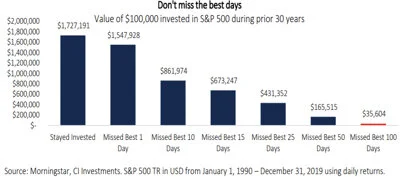MARKetS REPORT - Q1 2020
Defenceless under the night
Our world in stupor lies;
Yet, dotted everywhere,
Ironic points of light
Flash out wherever the Just
Exchange their messages:
May I, composed like them
Of Eros and of dust,
Beleaguered by the same
Negation and despair,
Show an affirming flame.
- W.H. Auden (1907-1973), from the poem September 1, 1939
Dear Client,
I want to express my sincere hopes that you and your family are healthy and managing well during this difficult period. I am writing to provide you with a quarterly update and information on how the COVID-19 pandemic has affected financial markets.
The first quarter of 2020 was unlike any we have seen in a very long time. In response to the pandemic and the social distancing and lockdown measures that have affected over one-third of the world’s population, global capital markets declined sharply. Energy prices also weakened significantly as a result of a price war between Russia and Saudi Arabia, further affecting the shares of energy companies and adding to the general atmosphere of anxiety in the markets. This was a stark contrast to the decade of gains investors had experienced since the end of the financial crisis in 2009. In fact, North American stock markets had reached all-time highs in February, on the heels of their strongest year since 2013.
The S&P 500 Index, a broad measure of U.S. equities, had the worst start to a year in history, down 20% (in U.S. dollars) over the three months ending March 31, while the Canadian S&P/TSX Composite Index posted its worst quarter since the financial crisis, declining 21.6%. Most other global markets had similar losses. The MSCI All Country World Index was down 21.7%. In commodities, oil was down to $20.48 per barrel (WTI US$). That is a 65.9% price reduction since the beginning of 2020. Natural gas was down 25.1%, copper down 20.6% and silver was down 21.7%. Only gold increased this quarter, up 3.9%. Government bonds also benefited from investors moving to safe havens, but yields moved lower as prices rose. The Canada Government’s bond yields are at 0.7% for 10 years and 1.3% for 30 years. The Canadian dollar declined in value over the quarter (as I have stated before, we have an oily dollar) and inflation was revised to 2.2% annually in February as per Statistics Canada.
As businesses were ordered closed to help stem the spread of the virus, central banks moved quickly to respond to the downturn with policies aimed at stabilizing the financial system, while the G7 countries announced that they would be willing to use “all appropriate policy tools” to provide economic support during the COVID-19 outbreak. Amidst surging unemployment numbers in both Canada and the U.S., the U.S. unveiled a US$2-trillion stimulus package, while the Canadian government’s commitment to fiscal support reached C$176 billion. The U.S. Federal Reserve (Fed) made two emergency cuts to its policy rate, bringing it to a range of 0-0.25%, while The Bank of Canada made three rate cuts to reduce its overnight lending rate to 0.25%. Along with other central banks, the Bank of Canada also initiated a program of bond purchases to encourage consumption growth and business investment. In the US, their Federal Reserve Board also committed to unlimited purchases of government bonds, mortgage-backed securities and, for the first time ever, corporate debt, in an attempt to ensure market liquidity and to take risk off private-sector balance sheets.
What does this mean for my investments?
We are living through circumstances that most people have never experienced. You would be unique indeed if you were not feeling the tiniest bit unsure about the world or your investments given recent events. Yet there are two vital points to keep in mind:
1) This is an event-driven decline, and while the recovery may prove to be a slow and gradual one, the COVID-19 pandemic will one day end. As far away as that may feel, it will run its course. In the meantime, the difficult part is avoiding the emotional decisions that can tempt investors to make ill-advised changes.
2) We did not build your portfolio to last until the next event. We built it for the long term. This does not come with the expectation that your investments would never experience declines; rather, your portfolio is built to withstand them so that it can carry you through to the next recovery and future gains.
Please keep these two foundational points in mind as you turn on the news or look at the day’s market action, which can admittedly add to your feelings of fear and uncertainty.
And while news surrounding COVID-19 continues unabated (you cannot escape the always on 24 hour news cycle), global markets have proven quite resilient as of late (as of print this week global stock markets are much higher than their lows on March 23rd). There may be a number of reasons for this reaction, including government stimulus and a hope that economies will be up and running sooner rather than later, but it has still confused many investors who expected further declines. The market pendulum swings, but sometimes it swings too much.
I want to leave you with a chart that demonstrates the importance of staying invested throughout downturns, and the risks of trying to time recoveries. While I may have shared this with you in the past, it illustrates the point so well that I believe there is no harm in seeing it again.
In closing, I would like to wish you and your family well during this unique time in all of our lives. Remember I am just an email or a phone call away.
All the best,
Mark McConnell, BA (Economics), DipBIS
Senior Investment Advisor, Branch Manager
Mandeville Private Client Inc. is a member of the Investment Industry Regulatory Organization of Canada and a member of the Canadian Investor Protection Fund.
This publication contains the opinion of the writer. The information contained herein was obtained from sources believed to be reliable, but no representation or warranty, express or implied, is made by the writer, Mandeville or any other person as to its accuracy, completeness or correctness. The information in this letter is derived from various sources, including CI Investments, Fidelity Investments, Insider Inc., Morningstar, Bloomberg, Yahoo Canada Finance, Trading Economics, TD Newcrest and PC Bond. This material is provided for general information and is subject to change without notice. Although every effort has been made to compile this material from reliable sources; no warranty can be made as to its accuracy or completeness, and we assume no responsibility for any reliance upon it. Before acting on any of the above, please contact me for individual financial advice based on your personal circumstances.

